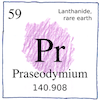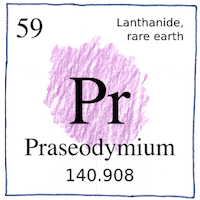Vienna—Carl Auer von Welsbach
elements

|
Praseodymium
Carl Auer von Welsbach separated two elements, praseodymium, the green twin, and neodymium, the new twin, from Mosander’s “didymium,” the twin of lanthanum.
Atomic number 59
Alloyed with neodymium strong permanent magnets. Alloyed with magnesium aircraft engines. Mixed with other rare earths in mischmetal. With others whose fluorides carbon arc lights. Whose compounds in glass and enamel a yellow hue. In didymium glass welder’s goggles. Whose ions doping silicate crystals slow light. Alloyed with nickel for magnetic refrigeration. In fluoride glass fibers an optical amplifier.
Into powder
In air, this stuff disappears into a powder like europium and lanthanum but more slowly. In Earth’s crust never pure.



Carl Gustaf Mosander had extracted the oxide of lanthanum from cerium, and called the pinkish residue as didymium, from the Greek word for “twins,” because of its similarity to lanthium. Paul-Émile Lecoq de Boisbaudran had already separated samarium from this residue, and Jean Charles Galissard de Marignac had separated gadolinium from it. Later, Eugène-Anatole Demarçay separated europium from Lecoq’s samarium.
See also in The book of science:
Readings in wikipedia:
Other readings: